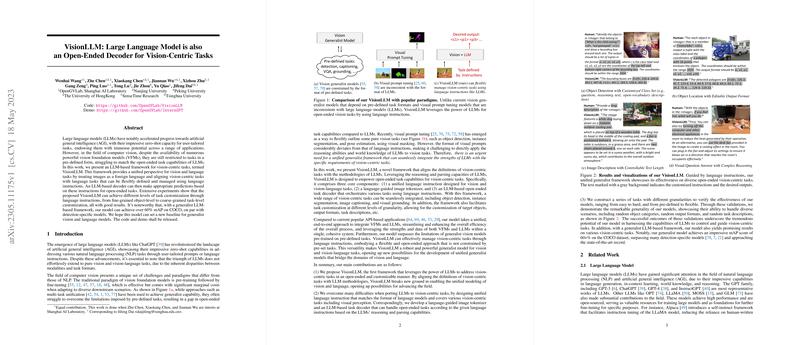Overview of "VisionLLM: LLM is also an Open-Ended Decoder for Vision-Centric Tasks"
The paper "VisionLLM: LLM is also an Open-Ended Decoder for Vision-Centric Tasks" introduces a framework designed to extend the capabilities of LLMs to vision-centric tasks. The authors have developed a novel system that aligns vision tasks with language tasks by treating images as a distinct form of language, thus establishing a unified framework for both vision and language domains.
Key Contributions
The paper makes several notable contributions to the field of generalist AI models:
- Unified Language Instruction: The framework employs a unified language instruction approach to define and customize vision-centric tasks. This method uses language prompts to manage tasks such as object detection, instance segmentation, and visual grounding, enabling LLMs to apply their reasoning capabilities to vision tasks effectively.
- Language-Guided Image Tokenizer: A novel image tokenizer is introduced, which captures visual information guided by language instructions. This allows the model to produce high-level feature representations that are aligned with provided language prompts, thereby facilitating better integration of vision and language capabilities.
- Open-Ended Task Decoder: The paper introduces an LLM-based decoder that processes vision tasks through a format consistent with language tasks. The decoder leverages the parsing and reasoning capacity of LLMs to manage various vision tasks using a shared set of instructions.
- Performance and Flexibility: On standard vision-centric benchmarks, VisionLLM achieves results competitive with specialist models, reporting over 60% mAP on the COCO dataset. This performance demonstrates the potential of using LLMs as open-ended decoders for vision tasks, thus proposing a new baseline for integrating vision and LLMs.
Practical and Theoretical Implications
The implications of this research are significant both practically and theoretically:
- Practical Implications: By unifying vision and language tasks under a single framework, VisionLLM reduces the need for task-specific models, thereby enhancing scalability and flexibility. This framework could pave the way for developing more versatile AI systems capable of handling complex, multimodal information processing.
- Theoretical Implications: The work challenges the traditional separation between vision and LLMs, suggesting that a unified approach can leverage the strengths of LLMs to perform vision tasks. This could influence future research directions, encouraging exploration into more integrated multimodal models.
Future Directions
The paper suggests several areas for future work:
- Integration of More Tasks: Expanding the set of tasks that can be effectively managed by VisionLLM could further demonstrate the model's generalist capabilities.
- Efficiency and Scalability: Future research could focus on optimizing the model's architecture for improved efficiency and scalability, particularly in resource-constrained environments.
- Refinement of Tokenization: Further refinement of the image tokenization process to capture more granular details could enhance the accuracy of fine-grained tasks like instance segmentation.
In conclusion, VisionLLM represents a significant step forward in the integration of vision and LLMs. By leveraging the flexible reasoning capabilities of LLMs for vision tasks, the authors have opened new avenues for research and development in artificial general intelligence. This work contributes to the broader effort of unifying cognitive tasks within a single, coherent framework.
